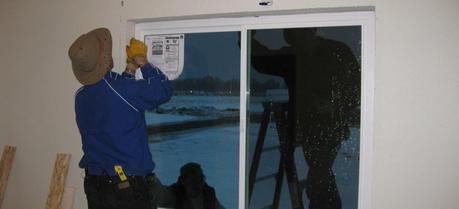 Installation of a triple-pane window in one of PNNL’s Lab Homes. (Credit: Pacific Northwest National Laboratory)
Installation of a triple-pane window in one of PNNL’s Lab Homes. (Credit: Pacific Northwest National Laboratory)
While comfort and other benefits are more immediate, it takes two decades or more for the triple-pane highly insulating windows to pay off financially based on utility-bill savings, according to a report by energy efficiency experts at the Department of Energy’s Pacific Northwest National Laboratory (PNNL).
The report (.pdf) by PNNL research engineer Sarah Widder and senior staff engineer Graham Parker is based on a study at PNNL’s Lab Homes, a pair of identical manufactured homes used to study energy efficiency. Researchers replace one item at a time in one home, such as the windows or the water heater, then compare the performance of the homes.
For this study, the PNNL team studied the effect of replacing aluminum-frame double-pane windows, which are common in homes across the country, with newer, triple-pane windows, also known as highly insulating windows. The team found that the newer highly insulating windows saved, on average, 5,821 watt-hours per day (W·h/day) or 279.5 kilowatt hours (kW·h) over the 70 days of the experiment. The overall whole-house energy savings were 11.6% ± 1.53% over the 70 day period. But because of the cost of the highly insulating windows, it would take anywhere from 23 to 55 years for the reduced energy cost to make up for the increased expense.
“A savings of 12 percent on whole-house energy consumption is substantial, especially when you’re talking about changing a relatively small percentage of a home’s envelope,” said Parker, a founder of the Lab Homes project. “But the windows are expensive.”
The team notes that there are many other factors to consider in addition to money when deciding whether to install highly insulating windows.
“Comfort is also important,” said Parker. “The windows cut down dramatically on cold air radiating from the windows and they reduce temperature variations in the home, where some areas will be much warmer or cooler than others. They also nearly eliminate the formation of condensation on the inside of the window which can lead to mold growth and unhealthy indoor air. It’s hard to put a dollar value on comfort and health.” Although not measured in this experiment, highly insulating windows also have the potential to significantly reduce the noise transmittance through windows compared to standard double-pane windows.
The PNNL team found an added value during summer months: The newer highly insulating windows, which have low-emissivity (low-e) coatings that reduce internal solar heat gain, slashed energy consumption by almost 25 percent during peak cooling times on hot summer afternoons. That benefit is passed along to utilities as less demand on the overall electricity grid at times when demand and price are highest, Widder said.
Low-emittance (low-e) coatings are microscopically thin, virtually invisible, metal or metallic oxide layers deposited on a window surface primarily to reduce the heat loss through the glass by suppressing radiative heat flow. The principal mechanism of heat transfer in multilayer glazing is thermal radiation from a warm pane of glass to a cooler pane. Coating a glass surface with a low-e material and facing that coating into the gap between the glass layers of multi-pane windows blocks a significant amount of this radiant heat transfer, thus lowering the total heat flow through the window.Another impact of reduced energy use that is important to mention from a utility and resource planning perspective is the ability to reduce peak load. The peak power consumed by the home with highly insulating windows installed was 33.9 ± 0.6% less than the peak power consumed in the other home. Although there is no direct financial benefit to most residential customers of a utility for peak reduction (customers with time-of-use rates notwithstanding), this significant reduction in peak power can be of benefit to the utility depending upon the time of the utility or system peak.

